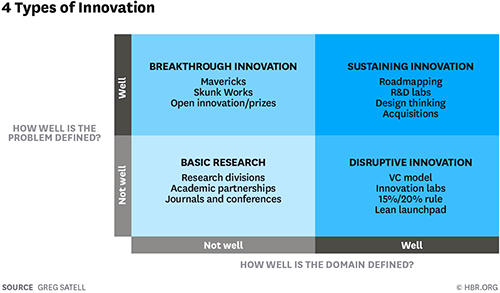The Four Types of Innovation – And Where to Study Them at Business School

In 1985, famous management thinker Peter Drucker famously declared “Innovate or die.” If businesses weren’t able to meaningfully separate themselves from their competitors, he argued, they would simply fail.
This incentive has only gained power in the last three decades. From the advent of the Internet to the onset of global warming, innovation across all industries is no longer just a competitive advantage, but a means of survival.
Innovation strategy is one of the key things students learn at business school – but what does innovation look like, and where do you start?
In this blog, we’ll take you through the four main types of innovation and how you can explore these on different business programs around the world.
How do we define innovation?
Innovation is such a buzzword that it can sometimes sound less like a real business concept than a magic spell for business success. But put simply, innovation is just problem-solving.
It’s identifying a problem that either has no current solution, an inadequate solution, or a solution that’s only available to a premium segment of the customer base and finding new solutions that problem.
Often, it changes the way that things are done in that industry. It can even transform the industry completely.
Is all innovation technological innovation?
Not all innovation is technological innovation, though it might seem like it at times. Many companies innovate using their existing resources and you don't need to invent a a revolutionary technology to be considered an innovator.
Much innovation comes from organizational innovation and creating new business models to challenge established companies and make headway in competitive markets.
Many innovative companies also pursue process innovation using existing technologies, or establish themselves as early adopters of new technologies that streamline their business.
So, if you're not a master programmer, fear not. There are many opportunities to pursue innovation without having to make rapid advances in technology.
Many business programs offer courses on innovation, or even dedicated innovation tracks. But to know which program is right for you, you first need to think about what kind of innovation you are most interested in.
The four types of innovation
Because innovation is a process of problem solving, it makes sense that it does not always look the same. There are as many ways of solving a problem as there are problems in business, but innovation tends to fall into four different categories.
These were outlined by business expert Greg Satell in his book, Mapping Innovation as sustaining innovation, breakthrough innovation, disruptive innovation, and basic research.
They are differentiated from each other chiefly by how well the problems they attempt to find new solutions for are defined, and how well the domain in which these problems exist is defined.

Here's what each of these types of innovation looks like in business and where you can study them at business school.
1. Sustaining, or incremental innovation
“Sustaining innovation” initially seems like an oxymoron. If innovation is about creating something new and better than what currently exists, then sustaining the status quo seems like the opposite. But this isn’t the case.
Sustaining innovation occurs when both the problem and the domain it exists in are well defined. It refers to when a company constantly makes small improvements on its products to sell them at higher prices to its best customers in order to sustain its competitive advantage and position as a market leader in an existing market.
One highly visible example of sustaining innovation is the smartphone market, in which providers regularly release better versions of the same product to compete with one another and generate sales.
If you’re aiming for a career in product management, a knowledge of how to manage sustaining and incremental innovation will be highly desirable to employers.
One of the places to study this is at the Massachusetts Institute of Technology (MIT) Sloan School of Management.
The school’s two-year, full-time MBA program offers three tracks, one of which is the Enterprise Management Track.
Students solve real business problems provided by outside organizations from day one, with core courses including marketing innovation and competitive strategy.
The program also offers a multi-disciplinary approach which studies show is highly conducive to innovative thinking and all types of innovation, not just sustaining innovations.
One meta-analysis examining almost 18 million scientific papers found that breakthroughs frequently occurred when the research was rooted in a traditional field with limited insight from another area of expertise.
Carnegie Mellon’s Tepper School of Business is also one to watch for sustaining innovation in product management careers. The New Product Management module on the full-time MBA aims to help students
-
Evaluate and value new product projects
-
Identifying opportunities for process innovation
-
Design and implement a study to optimize the product
-
Create a tailored launch marketing plan
Design thinking is also an invaluable skill for product management and sustaining innovation. An example of this at business school is the design thinking and innovation MBA concentration offered at the University of Michigan’s Stephen M Ross School of Business.
What's the difference between sustaining innovation and incremental innovation? Sustaining innovation is easily confused with incremental innovation, as both are processes of continuous improvement within existing markets. However there are some key differences.
While sustaining innovation focuses its innovation efforts on sustaining or increasing a company's market share to keep a competitive advantage, incremental innovation is more of a maintenance process to ensure that businesses do not get left behind.
It refers to when a company consistently improves its existing products and adds new features in order to keep their existing solutions up to date, for instance with new technology.
An example of incremental innovation might be when smartphone providers release updates to their operating systems. Unlike new hardware, these updates are to keep customers who own their existing products happy rather than drive new sales or establish themselves as a market leader.
2. Breakthrough innovation
We’ve spoken about how the current smartphone market is an example of sustained innovation. Well, the first smartphone was an example of breakthrough innovation.
When Apple released the first iPhone they essentially created a totally new product that has now become ubiquitous.
Breakthrough innovation is a kind of radical innovation that occurs when the problem you are trying to solve is well-defined, but the domain it exists in is still only operating at part of its potential.
You see breakthrough innovation happen when a new product is introduced to the market and creates a new demand that didn’t exist before. It doesn’t happen every day, but when it happens, it is often in highly supported environments such as larger businesses like Apple.
Business schools are a good place to learn about radical innovation because, due to their highly specialized research expertise, many business school professors consult on radical innovation efforts.
For example, Professor David K.C. Tse, Chair Professor of International Marketing and Director of the Contemporary Marketing Centre at HKU Business School has consulted on breakthrough innovations in MRI technology, and the HKU MBA has digital innovation at the core of its curriculum.
You might also use MBA entrepreneurship training to pursue intrapreneurship opportunities within larger businesses. Intrapreneurship refers to applying entrepreneurial concepts to new product development within an existing organization.
One example of this in action is the story of Lishini Karunatillaka who used MBA entrepreneurship training at Aston Business School to gather the skills needed to become an intrapreneur and pursue innovation in the clothing industry.
3. Disruptive innovation
Disruptive innovation occurs when a new product offering transforms the market it enters into. This occurs when the market or customer base is well-defined or understood, but the customers' problems have not been fully explored.
There are two main types of disruptive innovation:
-
Low-end disruption, when a company uses a low-cost business model to enter at the bottom of an existing market.
-
New-market disruption, in which a company creates and claims a new segment in an existing market by catering to an underserved customer base.
Usually, these two types of disruptive innovation occur as part of the same process.
The Ford Model T is a good example: it wasn’t designed to compete with the expensive cars owned by the wealthy elite, but to target a new segment of lower-income customers. It began as a low-end disruption targeting a new market and totally disrupted the automobile industry.
What's the connection between disruptive innovation and business model innovation? Learning how to spot opportunities for disruptive innovation is easier said than done.
In hindsight, it’s easy to see the customer bases that were not being served until disruptive innovations brought new products to them. But in practice, identifying these segments, developing a viable product, and building a new business model that can take it successfully to market, all requires considerable skill.
Perhaps the most obvious place to start learning these skills is with Harvard Business School online. Harvard includes a famous course on disruptive innovation as part of its online business certificate, taught by legendary professor Clayton Christensen, the professor who pioneered the term.
For aspiring startup leaders, prioritizing programs with strong links to startup communities that can help you hone your business model is important. Many of these programs offer workshops on creating business plans with a particular focus on business model innovation.
Examples of schools with built-in startup communities include
-
The MBA at Columbia Business School, where students can access networking, funding, and mentorship from successful entrepreneurs at the Eugene Lang Entrepreneurship Center.
-
IE University’s startup lab in Madrid, Spain, which gives students access to year-round workshops for students to develop their business plan
-
The National University of Singapore’s Startup Runway which supports early stage and growth stage founders with everything from legal advice to networking events
For existing business leaders, executive programs that focus specifically on innovation are a good investment. The Executive MBA for Entrepreneurship & Innovation at the Wharton School offers core courses in
-
Entrepreneurship through acquisition
-
A project-based in which students create one or more real businesses
-
Writing a comprehensive business plan and implementation plan
-
New product development
-
Venture capital and the finance of innovation
4. Basic research
Of course, almost every great innovation requires deep knowledge in a specialized area, and this is where research innovation comes in.
Basic research refers to the discovery of a new phenomenon that enables new problem solving techniques.
Larger companies include research in their innovation strategies by hosting research centres, labs, or accelerators. One example is Experian’s DataLabs project, which aims to innovate new data sources for use in financial services, telecommunications, and healthcare.
However, smaller companies can also access highly specialized research through local universities and, of course, business schools.
If you want to pursue innovation in a highly specialized area, selecting your business school based on its research faculty and research centers as well as the teaching available to you as a student is a great way to open these connections and be the first to hear of new discoveries.
The top-ranking schools for faculty research according to the Financial Times are
-
Harvard Business School
-
The Wharton School
-
The University of Chicago Booth School of Business
Perhaps you’re earlier in your career and considering getting stuck into this research yourself. In this case, you might study a specialized master’s to see if the business research life is for you.
One example can be found at EDHEC Business School, which offers a combined Master in Management and Masters of Science in Innovation and Data.
Innovation starts at business school
Now you know:
-
What innovation refers to
-
What the four main types of innovation are
-
Examples of these types of innovation in practice
-
Where you can go to find out more about them
But identifying the types of innovation you’re interested in is just the beginning.
Exploring these concepts and, importantly, putting them into practice in a supportive environment like business school can give you the launchpad to create a truly innovative business.
Register for the GMAT Now!
Register



